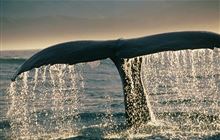Second Kaikoura sperm whale found dead
Archived content: This media release was accurate on the date of publication.
Introduction
The death of a second semi-resident Kaikoura sperm whale in a month has been met with concern by those who know the animals.Date: 30 July 2018
DOC staff were advised of a dead whale off-shore from Kaikoura which they located on the weekend of 21 July.
A series of buoys was attached to the animal, but it was not possible to tow it to shore due to sea conditions.
It hasn’t been seen since the weekend, at which point it was moving north, but DOC staff and harbourmasters are aware to keep an eye out.
Otago University and Whale Watch Kaikoura staff have confirmed the whale was a member of the Kaikoura canyon population, as was a whale found dead on Marfells Beach in early July.
DOC South Marlborough Operations Manager Phil Bradfield said the sad loss of these known animals is important to the Kaikoura area, which is struggling back to its feet after a hugely destructive earthquake.
“These whales underpin a significant part of the local economy but their loss will be especially felt by Ngāi Tahu and their hapu; Ngāti Kurī, who have a deep and profound attachment to whales and by our staff who commit a lot of effort and aroha into dealing with these animals and these situations.”
The stomach contents of the Marfells Beach whale were examined and found to be normal with no plastics or blockages, and a blubber sample was taken for stable isotope analysis which could give some insights on what the animals had been eating, but it is highly likely cause of death will never be known.
There are no previously recorded deaths of identifiable individuals from this population and the animals that feed here are typically young males, which makes a natural death of old age unlikely. The DOC marine mammal incidents database has 14 previous records of sperm whale deaths on the same stretch of coastline from 2009-1978, the majority of which occurred before 2000.
DOC Marine Species and Threats Technical Advisor Dave Lundquist said in the absence of any reliable evidence, the possible causes are likely to remain unknown.
“Changes to the Kaikoura canyon ecosystem due to the earthquake, compounded by changes due to La Niña conditions over the last summer may have left them weakened or more susceptible to other natural threats.
“There’s nothing to suggest that tourism or any other human activity has directly played a part in these deaths. We simply do not know why this has happened or whether other local Kaikoura whales will be similarly affected.”
Dr Lundquist said that due to the mass stranding of 13 sperm whales in Taranaki there have been a higher than usual number of sperm whale deaths around New Zealand coasts. DOC will continue to monitor the situation, but there is nothing at this stage to suggest it will have long-term consequences for the overall population of sperm whales in New Zealand.
Previous mass strandings in 1970 (59 stranded on Wainui Beach at Gisborne) and 1994 (72 stranded at Muriwai Beach) did not appear to affect the status of the population in New Zealand.
Ngati Kuri acknowledged the passing of the whale with a traditional farewell:
“Haere atu rā e te taonga a Tangaroa,
“Haere, haere, hana tū atu rā, he au te moe”
Contact
For media enquiries contact:
Email: media@doc.govt.nz

